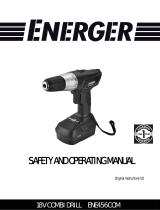
8
2.10 When using this machine for the first time and before actual work, you MUST learn
how to handle the machine from an experienced or skilled person.
2.11 Limit the amount of time using the machine continuously to somewhere around 10
minutes per session and take 10 to 20 minutes of rest between sessions. Also try to
keep the total amount of work in a single day limited to 2 hours or less.
2.12 NEVER allow children or anyone unable to fully understand the directions given in
this manual to operate this product.
2.13 Make sure you keep this manual handy so you may refer to it whenever questions
arise and ensure you pass this manual on if the machine is loaned or sold.
2.14 Hold the power tool by the insulated gripping surfaces when performing and operation
that may come in to contact with hidden wiring.
The drill coming into contact with a live wire may make exposed metal parts of the
power tool give the operator an electric shock.
2.15 If possible, always use clamps or a vice to hold your work.
2.16 Always switch off before putting the tool down.
2.17 Ensure that the lighting is sufficient.
2.18 Do not put pressure on the tool, such that it slows the motor down. Allow the bit to
screw without pressure. You will get better results and you will be taking better care of
your tool.
2.19 Keep the area free of tripping hazards.
2.20 Only use accessory bits in good condition.
2.21 Before starting, check that there is sufficient clearance for the bit under the workpiece.
2.22 Do not touch the bit after operation. It will be very hot.
2.23 Keep your hands away from under the workpiece.
2.24 Never use your hands to remove dust, chips or waste close by the bit.
2.25 Rags, cloths, cord, string and the like should never be left around the work area.
2.26 Support the work properly.
2.27 If you are interrupted when operating the tool, complete the process and switch off
before looking up.
2.28 Periodically check that all nuts, bolts and other fixings are properly tightened.
2.29 When using the tool, use safety equipment including safety glasses or shield, hearing
protection, and protective clothing including safety gloves. Wear a dust mask if the
operation creates dust.
2.30 WARNING
Some dust created by power sanding, sawing, and grinding, drilling, and other
construction activities contains chemicals known to cause cancer, birth defects or other
reproductive harm. Some examples of these chemicals are:
Lead from lead-based paints,




















